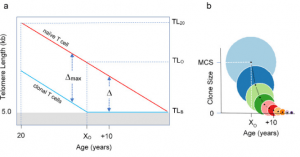Our ability to fight COVID-19 infection, and any other infection, depends on the ability of the immune system to replicate immune cells which target these infective agents. However, as you get older, the ability of our immune cells to replicate slows down and thus our ability to effectively fight off infection (READ MORE). In a new paper by Anderson, et al., the researchers established a detailed model which links COVID-19 mortality and age (Figure 1).

Figure 1: Age-dependent T-cell telomere length (TL) and its relation to T-cell clonal expansion. (a) displays age-dependent TL before (red) and after (blue) clonal expansion. Naïve T-cell clonal expansion shortens telomeres by Δ, where Δmax is T-cell telomere shortening resulting from expansion to form the maximal clonal size (MCS). The telomeric brink (TLB) of 5 kb is TL that increases the risk of cessation of replication. TL20 is TL at 20 years, TLO is telomeric onset, which indicates the shortest T-cell TL that enables attaining MCS. XO is age of onset of clonal expansion limitation. (b) displays T-cell clonal expansion size vs age from XO. Circle areas depict relative clonal size at and after XO. Light blue circle is MCS (Anderson, et al., 2022).
As DNA replicates during cell division, the end cap called the telomere, shortens following each replication. Following several replications, the cap gets too short and division stops. This is the case for immune cells. Additionally, the length of ones’ telomere is genetically inherited from their parents (READ MORE).
Using data which has been made publically available, the researchers built the model from data on COVID-19 mortality from the Center for Disease Control and US Census Bureau and other studies of telomeres.
Journal article: Anderson, J.J., et al., 2022. Telomere-length dependent T-cell clonal expansion: A model linking ageing to COVID-19 T-cell lymphopenia and mortality. EBioMedicine.
Summary by Stefan Botha










